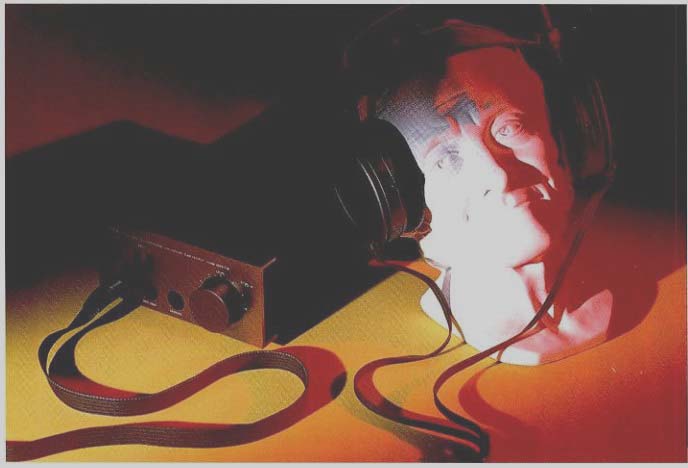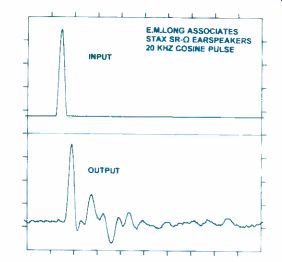
I was very interested in testing and evaluating the Stax SR-Omega electrostatic earspeakers to find out how they compare to the SR-Lambda Pros, which I have been using for nearly four years (see "Auricle," April 1991) as the reference when I have members of my listening panel judge the sonic qualities of earphones I am testing. (To avoid confusion, I must explain that "earspeakers" is the name Stax calls its earphones. I use the term "earphones" rather than "head phones" because it covers all types, including those you wear on your head as well as those you place in your ears.) Correlating the comments of panel members with the measured performance of earphones is very challenging. With the Stax SR-Lambda Pros, which are considered by many audiophiles to be among the best earphones available, the task is made easier.
Stax feels that the SR-Omegas improve upon the SR-Lambda Pros in three ways. The diaphragm has been enlarged and made circular, rather than rectangular. The fixed, gold-plated electrodes are more transparent to sound. And the six-strand, PC-OCC (Pure Crystal Ohno Continuous Casting) cable is 1 1/2 times wider, which reduces its resistance and capacitance.
As opposed to dynamic earphones, electrostatic earphones require no voice-coil. (The motion of the diaphragm is caused directly by electrostatic force.) This makes the diaphragm lighter, which usually improves transient performance and extends high-frequency response. Electrostatic ear phones require a high source impedance, high a.c. signal voltage, and high d.c. voltage bias. Accordingly, they cannot be operated directly from the earphone jacks on audio components but instead must be routed through a drive amplifier that meets their special requirements. I used the SR-Omega earspeakers to compare two Stax earphone amplifiers, the hybrid (FET and tube) SRM-T1S and the older, solid-state SRM-1/MK2. The former has a slight edge in clarity and detail, so I used it for the technical measurements and listening panel evaluations of the earspeakers. (I must caution anyone who might want to make the same comparison of amps: The SRM 1/MK2 inverts the absolute polarity of the sound, while the SRM-T1S has the correct polarity.)
=================
SPECS
EARSPEAKERS:
Transducer Design: Electrostatic.
Coupling to the Ear: Circumaural.
Frequency Response: 6 Hz to 41 kHz.
Impedance: 145 kilohms at 10 kHz.
Capacitance: 110 pF, including cable.
Sensitivity: 99 dB SPL at 100 V rms.
Maximum Output: 120 dB SPL at 400 Hz.
Bias Voltage: 580 V d.c.
Cable Length: 8.2 ft. (2.5 m).
Weight: 13.4 oz. (380 grams) without cable.
Price: $2,999.95.
DRIVE AMPLIFIER:
Frequency Response: 0 Hz to 44 kHz, +0,-1.5 dB.
Gain: 60 dB.
THD: 0.02% at 1 kHz for 100 V rms with earphone load.
Input Impedance: Unbalanced, 50 kilohms; balanced, 100 kilohms.
Output Level: 300 V maximum a.c. signal output at 1 kHz.
Dimensions: 7 5/8 in. W x 4 in. H x 14 3/4 in. D (19.4 cm x 10.2 cm x 37.5 cm).
Weight: 7 1/2 lbs. (3.4 kg).
Price: $1,599.95.
Company Address:
16920 Halldale Ave., Gardena, Cal. 90247.
=================
The SR-Omegas are larger than many earphones I have tested, but they feel rather light despite their 13.4-ounce weight; maybe it's because they are so very comfortable. These earphones are designed to be circumaural and open to outside sounds. As I have mentioned in previous reports, I prefer circumaural earcushions that completely encircle the outer ear rather than pressing against it. Pressure against the outer ear is the main contributor to discomfort, even more so than ear phone weight. That said, the large synthetic-leather earcushions on the SR-Omegas are among the best I have ever used. They not only encircle the outer ear completely but are very comfortable for long-term listening. Because the SR-Omegas don't exclude outside sounds, they might not be suitable in noisy locations or for monitoring recordings when you have to be in the same room with the musicians.
The earcups are 4 3/4 inches in diameter, and the earcushions are deep enough to keep the cloth barrier that covers the transducer from touching your outer ear. A metal screen protects the outer side of the earphones (as opposed to the plastic grille of the SR-Lambda Pros). The chamois-like headband is anchored by plastic sliders that move up and down in a plastic yoke; unlike some other earphones, the SR Omegas have a continuous adjustment, with no detents. The thin metal bails and the swivels on the bottom of the yoke also contribute to easy adjustment and good fit.
The wide ribbon cable has six conductors that run 7 feet from the special amp-input plug to a plastic clamp, which separates the cable into two three-conductor cables, each 15 inches long. A connector plugs into each earcup, allowing for re placement of the cable.

Fig. 1--Cosine-pulse test.
The SRM-T1S earphone amp can drive any of the Stax electrostatic earspeakers, supplying the necessary 580 V d.c. for the Pro Series earspeakers and 230 V d.c. for the standard models. The amp's hybrid de sign uses dual FETs and twin-triode 6FQ7 vacuum tubes in a direct-coupled circuit topology that is balanced from input to output; there are no capacitors or transformers in the signal path. The vacuum tube output provides an ideal, high a.c. signal voltage and a high impedance to drive the electrostatics. The balanced 100-kil ohm and unbalanced 50-kilohm input impedances are high enough that they will not cause loading problems with any pro gram sources. The SRM-T1S has plenty of output and can drive the SR-Omegas to very loud levels.
The amp has two pairs of gold-plated phono-input jacks and a pair of XLR three pin balanced inputs. Three earspeaker out puts are on the front panel; two are five-pin outputs for the Pro Series, which includes the SR-Omegas, and one is a six pin output for other Stax models. The volume control, configured with four potentiometers on a dual shaft, sets the signal levels for each channel; the concentric knobs are friction-coupled and can be turned separately to adjust channel balance.
The acoustical design of the SR-Lambda Pros requires separate electronics to achieve a diffuse-field characteristic; the SR-Omegas appear to have a diffuse-field characteristic without separate electronics.
My measurements of frequency response tended to verify this; the response was very smooth and extended beyond 20 kHz, except for a sharp dip at 6 kHz and a corresponding phase glitch. The output versus time response of the SR-Omegas (Fig. 1) shows a delayed response that may be the cause of the 6-kHz dip. The main output pulse is almost identical to the input pulse, which verifies the excellent high-frequency response; it also shows that the absolute polarity is positive (whereas the polarity of the SR-Lambda Pros is negative).
Before I had the panel members listen to the SR-Omegas, I spent some time listening to them using both the new and old earphone amps. I was quickly convinced that the SR-Omegas are superior to most Owing to their diffuse-field characteristic, the SR-Omegas have a more recessed sound than the SR-Lambda Pros do, which enhances the sense of space and depth. On the Strauss Violin Sonata in E-flat from Strauss & Dvorak (Sheffield Lab 10039-2F), the Omegas place the violin and piano back in the acoustic environment; the Lambda Pros bring the instruments more forward.
The percussion instruments on "0 Grande Amor" from Double Image's Open Hand (dmp CD-503) have a more pleasing sound when they are placed back, while retaining the transients of the mallet hits. Organ music played by Gillian Weir on Scherzo (Koss Classics KC-1013) sounds marvelous, with a great sense of acoustic space.
I also had panel members listen to "Time Alone" by Freyda & Acoustic AttaTude on Midnight at Cabell Hall (Red House RHR CD 55; phone, 415/457-9052).
The SR-Omegas did an excellent job with this binaural recording, which was made using an Aachen Head. The vocalist is placed back in a realistic space, and the sound of the strings is smooth and articulate. The final test was "Salve Regina" from a new recording of Gregorian chants, Angelic Voices (Renaissance Endeavors CD 102; phone, 800/747-7486) by The Daughters of Mary. The SR-Omegas place the choir back in a reverberant environment while still bringing out the clarity of the voices; this is often an impossible combi nation to achieve, and its success here is a tribute to the SR-Omegas and the good articulation of the choir.
I recommend the Stax SR-Omega ear-speakers to anyone who is serious about earphone listening.
-Edward M. Long
===========
EARPHONE EVALUATION
GENERAL COMMENTS: Excellent sense of spaciousness. Very good with binaural and conventional stereo recordings. Excellent bass. Clear and articulate on voice. Good value.
============
(adapted from Audio Feb. 1995)
Also see:
Stax SR-Lambda Professional Earspeaker System (Auricle, Jan. 1985)